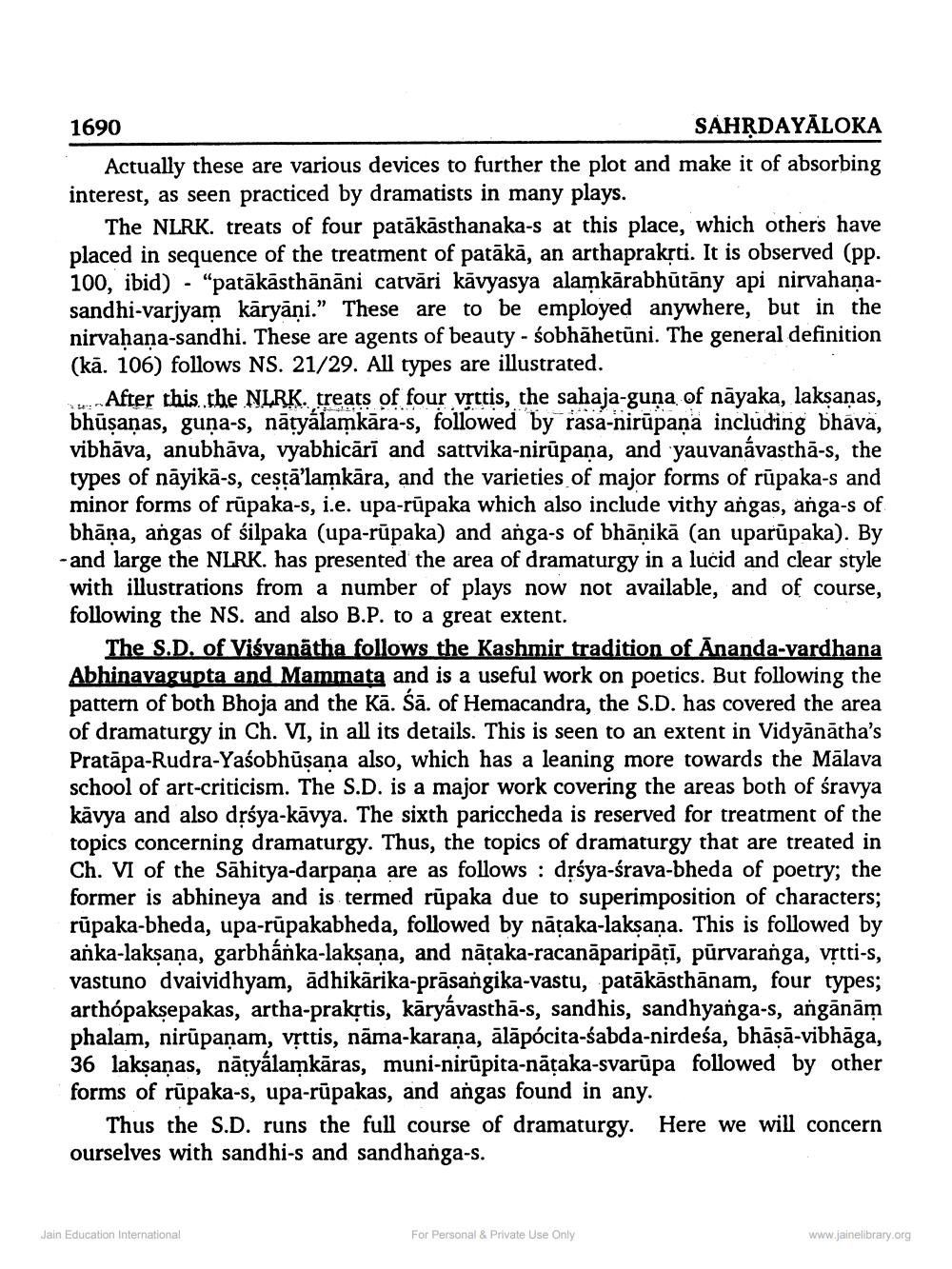________________
1690
SAHRDAYĀLOKA Actually these are various devices to further the plot and make it of absorbing interest, as seen practiced by dramatists in many plays.
The NLRK. treats of four patākāsthanaka-s at this place, which others have placed in sequence of the treatment of patākā, an arthaprakrti. It is observed (pp. 100, ibid). "patākāsthānāni catvāri kāvyasya alamkārabhūtāny api nirval sandhi-varjyam kāryāņi." These are to be employed anywhere, but in the nirvahana-sandhi. These are agents of beauty - sobhāhetūni. The general definition (kā. 106) follows NS. 21/29. All types are illustrated.
After this the NLRK. treats of four vrttis, the sahaja-guņa of nāyaka, laksaņas, bhūşaņas, guna-s, nātyálamkāra-s, followed by rasa-nirūpana including bhāva, vibhāva, anubhāva, vyabhicārī and sattvika-nirūpana, and yauvanávasthā-s, the types of nāyikā-s, cestā'lamkāra, and the varieties of major forms of rūpaka-s and minor forms of rūpaka-s, i.e. upa-rupaka which also include vithy angas, anga-s of bhāņa, angas of silpaka (upa-rūpaka) and anga-s of bhānikā (an uparūpaka). By - and large the NLRK. has presented the area of dramaturgy in a lucid and clear style with illustrations from a number of plays now not available, and of course, following the NS. and also B.P. to a great extent.
The S.D. of Viśvanātha follows the Kashmir tradition of Ananda-vardhana Abhinayagupta and Mammata and is a useful work on poetics. But following the pattern of both Bhoja and the Kā. Sā. of Hemacandra, the S.D. has covered the area of dramaturgy in Ch. VI, in all its details. This is seen to an extent in Vidyānātha's Pratāpa-Rudra-Yaśobhūsana also, which has a leaning more towards the Mālava school of art-criticism. The S.D. is a major work covering the areas both of śravya
and also drsya-kavya. The sixth pariccheda is reserved for treatment of the topics concerning dramaturgy. Thus, the topics of dramaturgy that are treated in Ch. VI of the Sahitya-darpana are as follows : drśya-śrava-bheda of poetry; the former is abhineya and is termed rūpaka due to superimposition of characters; rūpaka-bheda, upa-rūpakabheda, followed by nātaka-laksana. This is followed by anka-laksana, garbhánka-laksana, and nāțaka-racanãparipāțī, pūrvaranga, vstti-s, vastuno dvaividhyam, adhikarika-prāsangika-vastu, patākāsthānam, four types; arthópaksepakas, artha-prakstis, kāryavasthā-s, sandhis, sandhyanga-s, angānām phalam, nirūpanam, vrttis, nāma-karana, ālāpócita-sabda-nirdeśa, bhāsā-vibhāga, 36 laksaņas, nātyálamkāras, muni-nirūpita-nāțaka-svarūpa followed by other forms of rūpaka-s, upa-rūpakas, and angas found in any.
Thus the S.D. runs the full course of dramaturgy. Here we will concern ourselves with sandhi-s and sandhanga-s.
Jain Education International
For Personal & Private Use Only
www.jainelibrary.org




